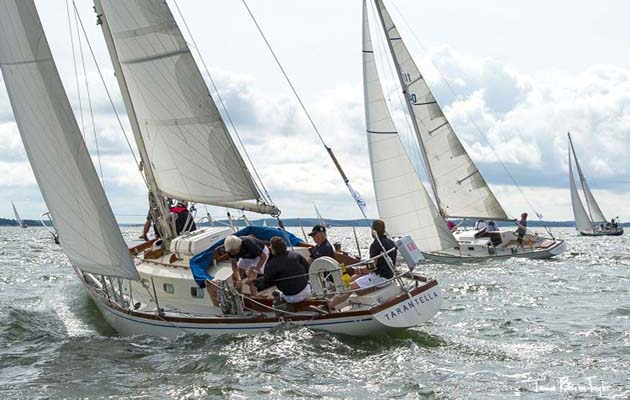
Photo: Spike Abram
6. Gunboat 62 Tribe
Built: 2001
Design: Morrelli & Melvin
When you are the son of the son of Bob Johnstone, one of the founders of J-Boats, keelboat sailing is in your blood. But when Peter Johnstone wanted to update his cruising yacht in the early Noughties he commissioned a 62ft catamaran.
Tribe was one of two custom Morrelli & Melvin designed 62ft cats commissioned by Clint Clemens and Peter Johnstone and built at Jaz Marine in Cape Town, South Africa. Combining comfort with racing yacht technology, Tribe reported intimidating speeds of 15 knots upwind and 30 downwind. The unique design was a big success and attracted a great deal of interest: the Gunboat concept was born.
Some years later Peter Johnstone formed Gunboat to build more 62-footers, subsequently Morrelli & Melvin also designed the Gunboat 66, 48, and 90 catamarans. Gunboat has since risen and fallen, before finally being sold. But the Gunboat brand continues, now under new ownership, and a slew of luxury performance catamarans from boatbuilders all over the world has since followed the innovative Tribe.
7. The Mirror dinghy
Built: 1962
Design: Jack Holt
Not a yacht, clearly, but the Mirror deservers a mention for bringing thousands of people into the sport. Jumping on the trend for home-building sailing dinghies in the 1960s, The Mirror newspaper commissioned designer Jack Holt and television DIY expert Barry Bucknell to come up with a family friendly boat, which could be built at home.
The Mirror, with red sails to match the red-top paper, cost £63 11s, and fitted on top of a car. It was a huge success, with more than 70,000 sold over the years. The class was part of a movement which saw the sport vastly expand and, thanks to its symmetric spinnaker, was also the teaching ground for many of Britain’s most successful sailors – Volvo Ocean Race winner Ian Walker is among its alumni.
8. Endeavour
Built: 1934
Design: Camper & Nicholson
By the 1970s it looked as if the J Class was destined to fade from history. Endeavour exemplified the Js’ plight, abandoned to sink on the River Medina. Ten years later she was completely restored.
“In his seminal book Enterprise to Endeavour yachting historian Ian Dear said in the 1970s that the likes of the J Class would never be seen again. And who could blame him! But he had to publish another edition when, to his delight, he was clearly proved wrong,” recalls David Glenn.
“The re-build of Endeavour by Elisabeth Meyer, and of Velsheda by Ronald de Waal towards the end of the last century, not only fired the starting gun for a resurgence in the J Class which today draws crowds like the Red Arrows, but was a catalyst for the boom in superyacht racing in the first 10 years of the 21st century.
“Their power and sheer beauty are genuinely timeless and modern materials have made them manageable. Their 100th birthday in 15 years time will be worth waiting for!”

9. Tarantella
Built: 1967
Design: Sparkman & Stephens
Tarantella was originally conceived for owner Pekka Koskenkyla who wanted a 36-footer built using the new glassfibre method.
S&S also adopted what was then a very modern keel arrangement, with a separate skeg and increased ballast aft, which reduced the hull wetted surface area and improved handling. The design became the first production Swan – 90 were built.

Photo: Jean Marie Liot
10. Pen Duick V
Built: 1969
Design: Michel Bigoin/Daniel Divergie
“My choice would be Eric Tabarly’s Pen Duick V. This aluminium 35ft monohull was the first offshore racing boat that used water ballast successfully,” says former Yachting World editor Andrew Bray.
Pen Duick V was the smallest of Tabarly’s famous line of yachts, but one of the most successful. In her Tabarly won the 1969 solo San Francisco to Tokyo Race, finishing more than 11 days faster than the next boat.



